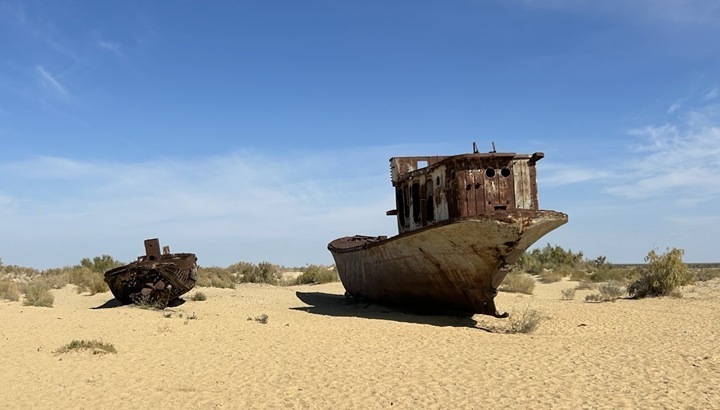Syrdarya River: the specter of the water crisis in Central Asia
New residential complexes are being actively built on both banks of the Syr Darya, and the embankment itself is undergoing a large-scale reconstruction. Heavy trucks are tamping freshly laid asphalt, and the pungent smell of bitumen is felt at a considerable distance. The new akim of Kyzylorda, Nurzhan Akhatov, appointed in August 2024, according to Kanat Utegenov, founder of the environmental laboratory LLP ECO GUARD, seeks to make the most of his short term of office, which explains the importance of the new landscaping.

“There is a lot of construction… it is visually noticeable to the population,” Utegenov told The Times of Central Asia. “Unfortunately, the economic feasibility of this is not always calculated.” As an example of one of these potentially failed projects, Utegenov cites a new stadium on the left bank of the river, which risks turning into a “white elephant” – an expensive but inefficient structure.
However, all this improvement depends on one critical factor, which is only partially under the control of Akim and only partially under the control of Kazakhstan. This factor is water. At the end of April, the view from the windows of the luxurious new apartments opens onto the sad sandy shores. Sandpipers methodically wander through the mud in search of worms. The dirty-gray river does not flow so much as it slowly creeps to the northwest. Some of this water will reach the Northern Aral Sea, the existence of which is supported by the Kokaral dam.
Utegenov attributes the low water level partly to climate change. “Winter has become milder and almost snowless,” he said, adding that low river levels in spring are not uncommon. “It is at this time that rice is planted; all the water goes into irrigation canals.”
Governments in the region are redoubling their efforts to produce rice, says Bulat Esekin, an expert on environmental and water policy in Central Asia. However, he points out that rice cultivation in this part of the world is incredibly inefficient. “If we take into account the full irrigation cycle, it takes five tons (5,000 liters) of water to grow just one kilogram of rice,” he told The Times of Central Asia. Nevertheless, the government of Kazakhstan is eager to trumpet success. The use of laser leveling technology in rice fields has helped to save more than 200 billion liters of water due to its more even distribution. According to Kazakh state media, this has led to an increase in yields from each hectare of rice by about 60-70%.
These measures do little to convince Yesekin, who considers them nothing more than a temporary solution. “Previously, there was no such need for technology, as there was enough water. Now such technologies have become necessary, because otherwise the crop simply cannot be grown. In countries with much more rainfall, such as Thailand or India, rice can be grown, but there are no prospects for it here. Sooner or later people will have to switch to other cultures.” Yessekin argues that the use of technological “quick solutions” demonstrates the paradigm problem of the authorities. “All these water-saving technologies… their goal is not to conserve or replenish water resources, but simply to increase water intake.”
The lack of focus on “conservation of water resources” instead of “water intake” can be observed a few hundred kilometers west of Kyzylorda, where the remnants of the Aral Sea fester like an ulcer in the heart of Central Asia. Two rivers flow into the Aral Sea: the Syr Darya and its southern sister, the Amu Darya. The runoff of each of them has sharply decreased over the past century, both during the Soviet period and in the era of independence.
The management of the Syr Darya’s flow requires the coordination of four countries: originating in the mountains of Kyrgyzstan, the river flows through Uzbekistan and Tajikistan before reaching Kazakhstan. Every year, these countries agree on quotas for the amount of water they can take from the river. Last year, Kazakhstan and Uzbekistan agreed to install digital monitoring stations to more accurately measure these flows. For these four thirsty nations, negotiations are difficult, especially considering that the river passes through the densely populated Fergana Valley. Therefore, most of the waters of the Syr Darya are allocated to Uzbekistan, the most densely populated country on its way.
Last year, thanks to unexpectedly heavy rainfall, no country came close to using its limit, and more water entered the Aral Sea than expected. Indeed, over the previous three years, the area of the Northern Aral Sea has increased by 111 km2, and its volume has increased by about 17% over the same period. However, Yessekin notes that this increase in water levels is not necessarily a positive sign. “Recent years have been a little better, but experts attribute this to the increased melting of glaciers. This is also not a good thing, because one day the melting period will end.”
Water quota negotiations often involve a lot of controversy. Disagreements are especially fierce in the upper reaches of the Syr Darya, says Yevgeny Simonov from the ecological coalition Rivers Without Boundaries. He explains that during the Soviet period, large reservoirs were built, such as the Toktogul reservoir in Kyrgyzstan, to regulate the flow of water to the lower reaches and make it more predictable. However, according to him, after gaining independence, Kyrgyzstan began to convert these reservoirs to meet its energy needs.
“This caused significant disruptions in water use downstream,” Simonov told The Times of Central Asia. When water is used to generate electricity in hydroelectric power plants in winter, the side effect is an increase in the flow of water downstream, which can cause flooding. The reverse situation is observed in summer, when there is not enough water in the lower reaches due to its accumulation in the reservoirs of the upper reaches. “Until now, the upstream countries (Kyrgyzstan and Tajikistan) have consistently refused to develop mutually enforceable agreements with their downstream neighbors, which limits their ability to distort seasonal river flow by regulating reservoirs,” Simonov said, adding that the inconvenience was so great that it led Kazakhstan to build its own reservoir – Koksarai – to try to get a little more control over the water flow.
Simonov warns that future projects, including the Kambar-Ata HPP-1, the planned Kyrgyz reservoir, are likely to become the subject of new disputes. “To make this development safe for downstream countries, upstream neighbors need to agree on a mutually binding agreement on the use of the entire cascade for the common good. This has not happened so far, so further friction is possible,” he said.
The history of the Syr Darya is part of a broader systemic failure driven by short-term political cycles and urgent economic needs. Esekin notes that dams and reservoirs, which are being built under the pretext of adapting to climate change, but in reality are being built for economic and energy purposes, act as “thrombi” on rivers. “With each such action, we strengthen, accelerate and aggravate the cause leading to the degradation of the entire ecosystem,” he said.
Despite the scientific knowledge and the presence of experts in government circles, the pressure to achieve visible results within a limited political timeframe narrows the planning horizon to several years, which is too short to solve long-term problems of water and climate crises.
In 2023, the first global water conference in more than fifty years was held in New York. At it and at regional summits, such as last week’s international conference on glacier conservation in Dushanbe, there has been a surge in rhetoric around sustainable water management. However, there is a contradiction between what the Governments of the Central Asian countries declare at the international level and what they pursue within their countries. The most egregious is the region’s inability to get rid of dependence on the production of cheap cotton, a crop that is almost as water–intensive as rice, using four tons of water for every kilogram produced.
Without a fundamental change in water use habits in the entire Syrdarya region and the Aral Sea basin as a whole are at risk of further degradation. The potential consequences, Esekin notes, can be serious: “All recommendations, advice and warnings that conflicts, war or famine will arise in three to five years are simply not taken into account. This is the main tragedy of our system.”
Original (in Russian): Река Сырдарья: призрак водного кризиса в Центральной Азии


